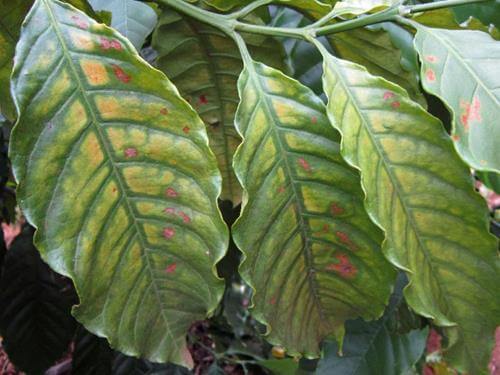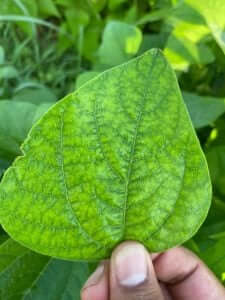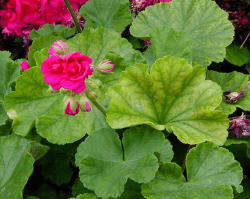
Deficiencia de Magnesio
Magnesium Deficiency
-
Pathogen:
Nutritional disorder
Type:
Risk to the plant:
INTERMEDIÁRIO



DESCRIPTION
WHO CAUSES IT?
Magnesium is an essential secondary macronutrient and the central nucleus of chlorophyll, so its deficiency directly affects photosynthesis and growth. It is also involved in the activation of numerous enzymes and in the synthesis of carbohydrates and proteins. Deficiency usually occurs in acidic, sandy soils, or soils with excess calcium, potassium, or aluminum, which hinder its absorption. Since magnesium is mobile in the plant, symptoms first appear on older leaves.
SYMPTOMS
Magnesium deficiency causes interveinal chlorosis, beginning in older leaves and progressing to newer leaves if not corrected.
Typical symptoms:
• Yellowing between the veins of older leaves (interveinal chlorosis).
• Leaf margins remain green while the center turns yellow.
• Small or wilted leaves.
• Loss of vigor and slow plant growth.
• In severe cases, leaves show necrotic spots and premature leaf drop.
• Decreased fruit and seed production.
Magnesium deficiency progresses gradually and affects the plant's photosynthetic capacity and overall metabolism, compromising yield and harvest quality.
Developmental stages:
• Initial: interveinal chlorosis in older leaves, while the veins remain green.
• Intermediate stage: more intense chlorosis and the appearance of necrotic spots.
• Advanced: leaves with dead tissue and premature leaf drop.
• Final: growth stopped, small or deformed fruits and loss of yield.




TEMPERATURE AND HUMIDITY
-
-

HOW IS IT SPREAD?
-

HOW TO REMOVE IT?
Home remedies
There are no home treatments
Chemical treatments
• SOLUBLE MAGNESIUM FERTILIZERS: Magnesium sulfate (Epsom salts); rapid foliar or root absorption.
• ENCAPSULATED / CONTROLLED-RELEASE FERTILIZERS: Provide Mg gradually in light soils.
• ORGANIC FERTILIZERS + MAGNESIUM: Enriched compost and manure; improve structure and retention.
• AMINO ACIDS + MAGNESIUM FERTILIZERS: High foliar absorption, corrects deficiencies immediately.
Treatments allowed in organic farming
• SOLUBLE MAGNESIUM FERTILIZERS: Magnesium sulfate (Epsom salts); rapid foliar or root absorption.
• ENCAPSULATED / CONTROLLED-RELEASE FERTILIZERS: Provide Mg gradually in light soils.
• ORGANIC FERTILIZERS + MAGNESIUM: Enriched compost and manure; improve structure and retention.
• AMINO ACIDS + MAGNESIUM FERTILIZERS: High foliar absorption, corrects deficiencies immediately.
Insect allies
PREDATORY MITES
LADYBUGS
LACEWINGS
PARASITIC WASPS
HOVERFLIES OR PARASITIC FLIES
PREDATORY BUGS
There are no natural allies
Mycodiplosis oidii (predatory mosquito)
EFFECTIVE PRODUCTS TO ELIMINATE THIS DISEASE
Sponsored link
Sponsored link
Sponsored link
Sponsored link
Sponsored link
Sponsored link
Sponsored link
Sponsored link
Sponsored link
Effective against all types of fungi
Sponsored link
Sponsored link
Sponsored link
Sponsored link
Sponsored link
Sponsored link
Sponsored link
To maintain adequate magnesium levels and promote photosynthesis and healthy growth, it is important to implement practices that optimize its availability in the soil and its uptake by the roots.
• Apply magnesium-rich fertilizers, such as magnesium sulfate (Epsom).
• Incorporate compost or well-rotted manure.
• Maintain even irrigation to facilitate absorption.
• Avoid excess calcium, potassium, or aluminum, which could block its availability.
• Correct soil pH if it is outside the optimal range.
• Control weeds that compete for nutrients.
• Maintain adequate levels of organic matter in the soil.
























